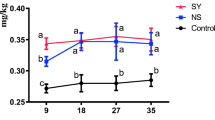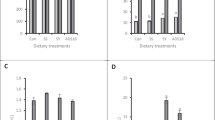Abstract
A 6-week trial was conducted to compare the effect of selenium (Se) from hydroponically produced Se-enriched kale sprout (HPSeKS), sodium selenite (SS), and Se-enriched yeast (SeY) in laying hens. A total of 144 40-week-old hens were randomly divided into four groups, according to a completely randomized design. Each group consisted of four replicates with nine hens per replicate. The dietary treatments were T1 (basal diet) and T2, T3, and T4 (basal diets supplemented with 0.30 mg Se/kg from SS, SeY, and HPSeKS, respectively). Results showed that Se supplement did not affect (p > 0.05) productivity and egg quality. Hens fed Se from HPSeKS and SeY exhibited higher (p < 0.05) Se bioavailability than hens fed Se from SS. Whole egg Se concentration of hens fed Se from HPSeKS was similar (p > 0.05) to that of hens fed Se from SeY, but higher (p < 0.05) than that of hens fed Se from SS. However, the breast muscle and heart tissue Se concentrations of hens fed Se from SS, SeY, and HPSeKS were not different (p > 0.05). The results of this trial demonstrated that Se from HPSeKS and SeY was more efficient than Se from SS on Se bioavailability and whole egg Se concentration in laying hens.
Similar content being viewed by others
References
Gupta M, Gupta S (2017) An overview of selenium uptake, metabolism, and toxicity in plant. Front Plant Sci 7:1–14
Surai PE, Fisinin VI (2014) Selenium in poultry breeder nutrition: an update. Anim Feed Sci Technol 191:1–15
Juniper DT, Phipps RH, Jones AK, Bertint G (2006) Selenium supplementation of lactating dairy cows: effect on selenium concentration in blood, milk, urine, and feces. J Dairy Sci 89:3544–3551
Zhan XA, Wang M, Zhao RQ, Li WF, Xu ZR (2007) Effect of different selenium source on selenium distribution, loin quality and antioxidant status in finishing pigs. Anim Feed Sci Technol 132:202–211
Baylan M, Canogullari S, Ayasan T (2011) Effects of dietary sources, storage time, and temperature on the quality of quail eggs. Biol Trace Elem Res 413:967–974
Celi P, Selle PH, Cowieson AJ (2013) Effects of organic selenium supplementation on growth performance, nutrient utilization, oxidative stress and selenium tissue concentrations in broiler chickens. Anim Prod Sci 54:966–971
Chantiratikul A, Chinrasri O, Chantiratikul P (2008) Effect of sodium selenite and zinc-L-selenomethionine on performance and selenium concentrations in eggs of laying hens. Asian-Aust J Anim Sci 21:1048–1052
Reis RN, Virira SL, Nascimento PC, Pena JE, Barros R, Torres CA (2009) Selenium contents in egg from broiler breeders supplemented with sodium selenite or zinc-L-selenomethionine. J Appl Poult Res 18:151–157
Delezie E, Rovers M, Van der Aa A, Ruttens A, Wittocx S, Segers J (2014) Comparing responses to different selenium sources and dosages in laying hens. Poult Sci 93:3083–3090
Jing CL, Dong XF, Wang ZM, Liu S, Tong JM (2015) Comparative study of DL-selenomethionine vs sodium selenite and seleno-yeast on antioxidant activity and selenium status in laying hens. Poult Sci 94:965–975
Jlali M, Briens M, Rouffineau F, Mercerand F, Geraert PA, Mercier Y (2013) Effect of 2-hydroxy-4-methylselenobutanoic acid as a dietary selenium supplement to improve concentration of table eggs. J Anim Sci 91:1745–1752
Briens M, Mercier Y, Rouffineau F, Mercerand F, Geraert PA (2014) 2-hydroxy-4-methylselenobutanoic acid induces additional tissue selenium enrichment in broiler chicken compared with other selenium sources. Poult Sci 93:85–93
Tufarelli V, Ceci E, Laudadio V (2016) 2-Hydroxy-4-methylselenobutanoic acid as new organic selenium dietary supplement to produce selenium-enriched eggs. Biol Trace Elem Res 171:453–458
Dlouha J, Livanský K, Kotrbáček V, Zachleder V (2009) Production of Chlorella biomass enriched by selenium and its use in animal nutrition: a review. Appl Microbiol Biotechol 83:1001–1008
Skřivan M, Skřivanova V, Dlouhá G, Brányiková I, Zacjleder V, Vítová M (2010) The use of selenium-enriched alga Scenedesmus quadricauda in a chicken diet. Czech J Anim Sci 55:565–571
Pan C, Zhao Y, Liao SF, Chen F, Qin S, Wu X, Zhou H, Huang K (2011) Effect of selenium-enriched probiotics on laying performance, egg quality, egg selenium content, and egg glutathione peroxidase activity. J Agri Food Chem 59:11424–11431
Ellis DR, Salt DE (2003) Plants, selenium and human. Curr Opin Plant Biol 6:273–279
Rayman MP, Infante HG, Sargent M (2008) Food-chain selenium and human health: spotlight on speciation. Br J Nutr 100:238–253
Maneetong S, Chookhampaeng S, Chantiratikul A, Chinrasri O, Thosaikham W, Sittipout R, Chantiratikul P (2013) Hydroponic cultivation of selenium-enriched kale (Brassica oleracea var. alboglabra L.) seedling and speciation of selenium with HPLC-ICP-MS. Microchem J 108:87–91
Chinrasri O, Chantiratikul P, Maneetong S, Chookhampaeng S, Chantiratikul A (2013) Productivity and selenium concentrations in egg and tissue of laying quails fed selenium from hydroponically produced selenium-enriched kale sprout (Brassica oleracea var. alboglabra L.) Biol Trace Elem Res 155:381–386
Chantiratikul A, Pakmaruek P, Chinrasri O, Aengwanich W, Chookhampaeng S, Maneetong S, Chantiratikul P (2015) Efficacy of selenium from hydroponically produced selenium-enriched kale sprout (Brassica oleracea var. alboglabra L.) in broilers. Biol Trace Elem Res 165:96–102
Chantiratikul A, Borisuth L, Chinrasri O, Saenthaweesuk N, Chookhampaeng S, Thosaikham W, Sriart N, Chantiratikul P (2016) Evaluation of the toxicity of selenium from hydroponically produced selenium-enriched kale sprout in laying hens. J Trace Elem Med Biol 35:116–121
NRC (1994) Nutrition requirement of poultry, 9th edn. National Academy Press, Washington, DC, pp 44–45
Haugh RR (1937) The Haugh units for measuring egg quality. US Egg Poult Mag 43:552–555
AOAC (1999) Official methods of analysis, 16th edn. Association of Official Analysis Chemists, Washington, DC
Kapolna E, Fodor P (2006) Speciation analysis of selenium enriched green onions (Allium fistulosum) by HPLC-ICP-MS. Microchem J 84:56–62
Seo TC, Spallholz JE, Yun HK, Kim SW (2008) Selenium-enriched garlic and cabbage as a dietary selenium source for broilers. J Med Food 11:687–692
SAS (1996) SAS/STAT® user’s guide (release 6.03 ed.). SAS Inst. Inc., Cary
Bennet DC, Cheng KM (2010) Selenium enrichment of table eggs. Poult Sci 89:2166–21672
Invernizzi G, Agazzi A, Ferroni M, Rebucci R, Fanelli A, Baldi A, Orto VD, Savoini G (2013) Effects of inclusion of selenium-enriched yeast in the diet of laying hens on performance, eggshell quality, and selenium tissue deposition. Ital J Anim Sci 12e1:1–8
Jaikui L, Xiaolong W (2004) Effect of dietary organic versus inorganic selenium in laying hens on the productivity, selenium distribution in egg and selenium content in blood, liver and kidney. J Trace Elem Med Biol 18:65–68
Chinrasri O, Chantiratikul P, Thosaikham W, Atiwetin P, Chumpawadee S, Saenthaweesuk S, Chantiratikul A (2009) Effect of selenium-enriched bean sprout and other selenium sources on productivity and selenium concentration in eggs of laying hens. Asian-Aust J Anim Sci 22:1661–1666
FDA (2003) 21 CFR 573.920, Food additives permitted in feed and drinking water of animals: selenium, amended at Fed Regis. 68:52339–52340
The Commission of the European Communities (2013) Commission Implementing Regulation (EU) No 427/2013 of 8 May 2013. In: Off J EU 2013 L127/20
Ort JE, Latshaw JD (1978) The toxic level of sodium selenite in the diet of laying chickens. J Nutr 108:1114–1120
Latshaw JD, Osman M (1975) Distribution of selenium in egg white and yolk after feeding natural and synthetic selenium compound. Poult Sci 54:1244–1252
Dobrzanski Z, Jamroz D (2003) Bioavailablity of selenium and zinc supplied to the feed for laying hens in organic and inorganic form. Elect J Polish Agri Univ 6:1–6
Pedrero Z, Madrid Y, Camara C (2006) Selenium species bioaccessibility in enriched radish (Raphanus sativus): a potential dietary source of selenium. J Agric Food Chem 54:2412–2417
Finley JW (1998) The absorption and tissue distribution of selenium from high-selenium broccoli are different from selenium from sodium selenite, sodium selenate, and selenomethionine as determined in selenium-deficient rats. J Agric Food Chem 46:3702–3707
Banuelos GS, Mayland HF (2000) Absorption and distribution of selenium in animals consuming canola grown for selenium phytoremediation. Ecotoxicol Environ Saf 46:322–328
Navarro-Alarcon M, Cabrera-Vique C (2008) Selenium in food and the human body: a review. Sci Total Environ 400:115–141
Pan C, Huang K, Zhao Y, Qin S, Chen F, Hu Q (2007) Effect of selenium source and level in hen’s diet on tissue selenium deposition and egg selenium concentrations. J Agri Food Chem 55:1027–1032
Chantiratikul A, Chirasri O, Pakmaruek P, Chantiratikul P, Thosaikham W, Aengwanich W (2011) Responses of growing Japanese quails received selenium from selenium-enriched kale sprout (Brassica oleracea var. alboglabra L.) Biol Trace Elem Res 144:760–768
Combs GF (2001) Selenium in global food systems. Br J Nutr 58:517–547
Acknowledgments
The financial support was provided by the Mahasarakham University Development Fund and the Center of Excellence for Innovation in Chemistry (PERCH-CIC), Commission on Higher Education, Ministry of Education. The authors are grateful to Phytobiotics Feed Additive GmbH for providing Se-enriched yeast (Cytoplex-Se® 2000).
Author information
Authors and Affiliations
Corresponding author
Ethics declarations
This study was approved by the Animal Ethics Committee of Mahasarakham University.
Conflict of Interest
The authors declare that they have no conflict of interest.
Rights and permissions
About this article
Cite this article
Chantiratikul, A., Chinrasri, O. & Chantiratikul, P. Effect of Selenium from Selenium-Enriched Kale Sprout Versus Other Selenium Sources on Productivity and Selenium Concentrations in Egg and Tissue of Laying Hens. Biol Trace Elem Res 182, 105–110 (2018). https://doi.org/10.1007/s12011-017-1069-0
Received:
Accepted:
Published:
Issue Date:
DOI: https://doi.org/10.1007/s12011-017-1069-0




